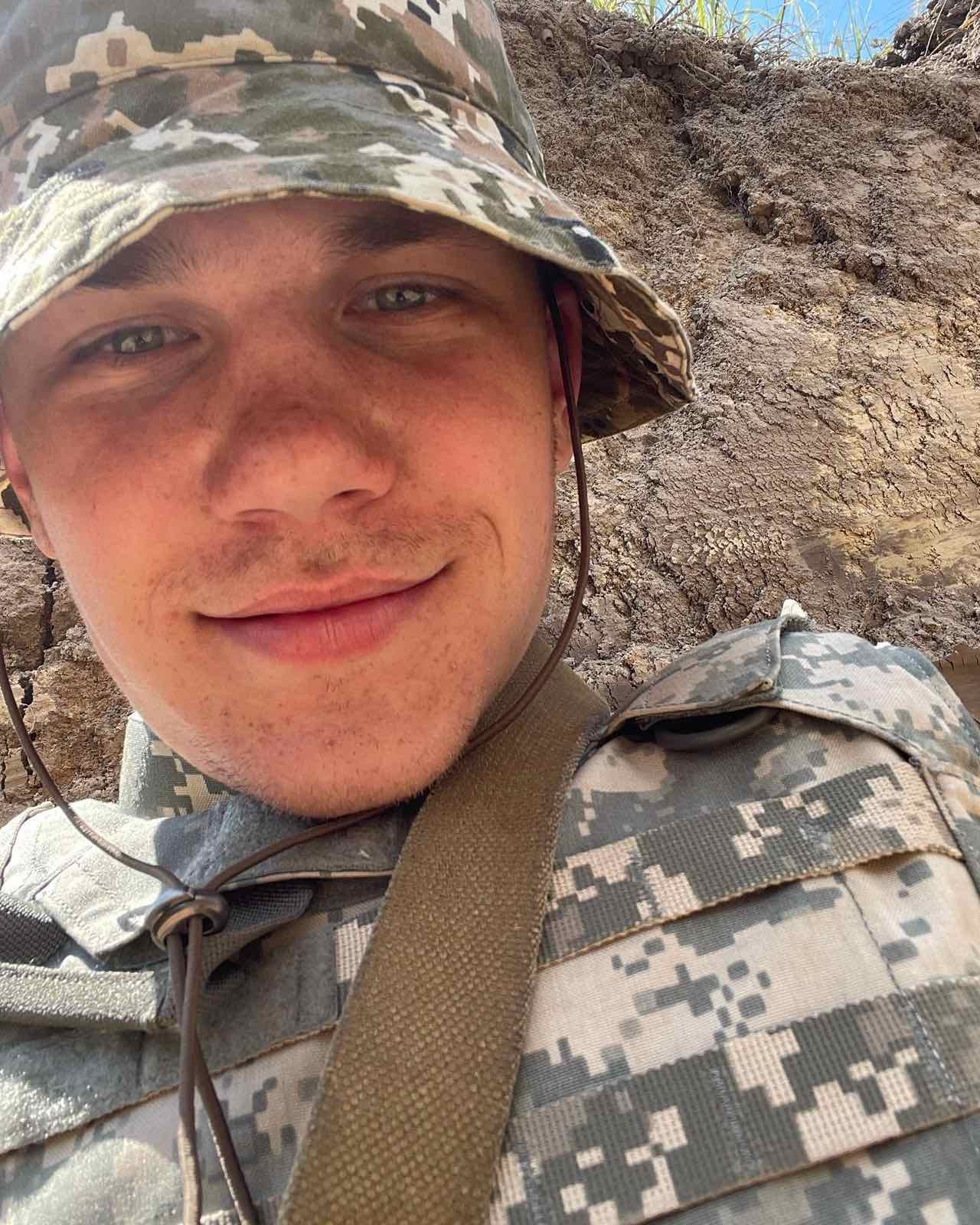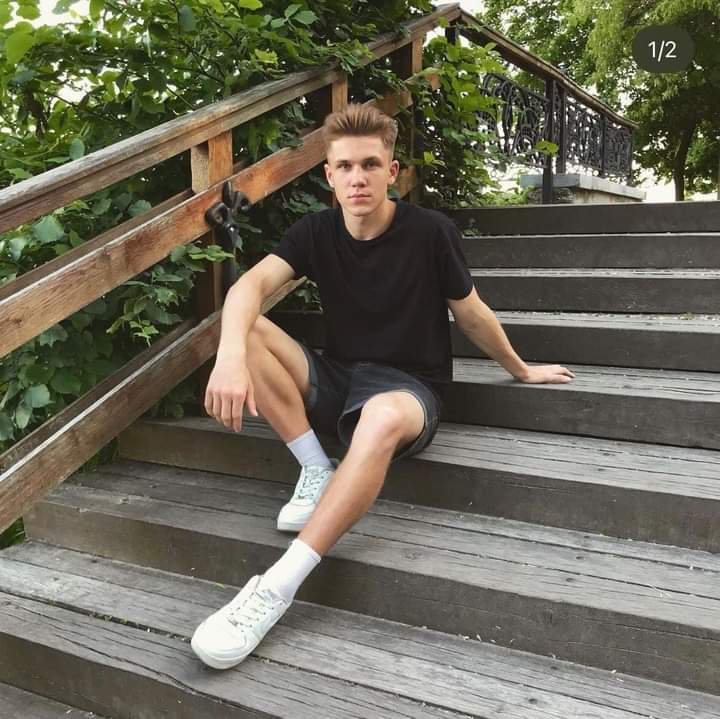Three shots from the Grad. A 19-year-old soldier lost his leg due to the inability to evacuate him in time
“The fever dropped a little, but it does not fall below 39 C (102.2 F). Today (March 20 - ed.) was the third surgery, the next one is tomorrow,” 19-year-old Dmytro Tereshchenko, a soldier of the 119th Territorial Defense brigade, separate 167th battalion with the call sign "Champion", native of Chernihiv, says by phone. “They are removing the fragments. They are in the lungs, kidneys, and stomach. The armor did not protect me at all, everything went through it,” he adds. “Doctors say, now I have two birthdays. Because people don't survive with such injuries.”
Translated by Dmitry Lytov & Mike Lytov
Читати українською

The enemy had us in full view
Dmytro is a third-year student of the Faculty of Physical Education of the Chernihiv Collegium National University (former Pedagogical University), a boxer, a candidate for master of sports (coach Ihor Marchenko), a member of the regional boxing team. On February 26, at the age of 18, he joined the Chernihiv Territorial Defense, then the Armed Forces of Ukraine. He came under artillery fire on March 13, 2023 at around 1:00 p.m. near the village of Bilohorivka, on the border of Donetsk and Luhansk regions.
The guys carried us on foot about 3 km through a mountainous area under enemy fire
“With Serhii Komisarenko from Snovsk and Kostiantyn Mazko and Stanislav Mozgovenko from Chernihiv, we stood in formation and inspected the positions. Suddenly there was a sound. It flew very close by, we were all concussed. The next three shots from the "Grad" hit us. There was screaming, yelling, swearing. I was wounded in my left shoulder, stomach and right leg. Blood was flowing out. I looked at Serhii - he was wheezing and bleeding. He was dying before my eyes. He was 54 years old, had adult children and grandchildren. Kostia's leg was barely holding on to some bone. Stanislav had a head injury. And I was crippled myself, I could not help them. I tied a tourniquet on myself. We radioed that we needed help. The walkie-talkie was also damaged by shelling fragments, worsening the connection. Our guys did not hear us immediately.
The Russian military was about 2 km away. We later found out that they had us in full view, and they even listened in on our communications.
Kostia was the first to be taken to the evacuation point. Then me. The car could not get through the terrain. The guys from the battalion carried us on foot for about 3 km through the mountainous terrain, which was shot through. Heavy artillery worked on them. They fired 150-mm shells. One of our guys was wounded - a fragment flew into his neck. Kostiantyn's leg was amputated below the knee. Stanislav had a severe head injury.”
Waiting until dark
“They put me on a stretcher. They said to wait until dark. The orcs (=Russians) behave a little more quietly at night, as not everyone can see where to shoot. Then I developed pneumothorax (accumulation of air in the pleural cavity with a simultaneous increase in pressure in it, as a result of which the lungs gradually collapse - author), but no one noticed this. Time passed. Blood was flowing from my leg. The guys tied on two more tourniquets.
I was carried to the evacuation point in the dark on a cloth stretcher by eight comrades. While they carried me, there was whistling in the air above us.
In the stabilization center (the first point after the frontline, where help is provided), I was injected with painkillers and two tourniquets were removed. From there, they brought us to Kramatorsk at around 9:30 p.m., and at the same time, the last tourniquet was removed.
Tourniquets remained tightened for more than 6 hours. The normal time is up to 2 hours. The leg virtually died.
The doctors did everything possible, but they were unable to save the leg. They had to cut it off above the knee. Then I was transported to Dnipro. The doctors examined me and found dead tissue. They found it necessary to perform a re-amputation - the leg was cut off completely. Now I am in a hospital in Kyiv, in Feofania. My guardian angel is my girlfriend Katia. We’ve been together for more than 5 years, since school.”
“Is the second leg intact?”
“It is. All is well.”
"Mom, I'm in Bukovel. I put on a hat"
Dmytro's mother, 41-year-old Iryna Tereshchenko, says that her son is a lifelong fighter, he practiced boxing for a long time and won prizes, but after the injury, he completely lost heart.
"He worries about me more than himself," she explains. “He and my younger 11-year-old son are my support in life. I raised Dmytro all by myself, his father was never interested in him. On occasions, I screamed and cried, but you can't help with screams. But moms will endure anything. We are strong women, and our warriors are brave.”
“When did Dmytro go to the east?”
“I found out that he was going to Donetsk on the evening of December 10, the day before the trip. We talked every day. He sent me a photo and joked: "Everything is fine. I'm in Bukovel (a ski resort in Ukraine — ed.). I put on a hat."
We lived in holes, ate field rations
In the hospital, Dmytro recalls the details of three months of life on the front lines:
“We lived in holes dug by the katsaps (=the Russian occupiers). Not dugouts, not trenches, but holes. Our amphibious assault brigade chased them away from there. Then we improved the holes a little to our liking. But it was not a shelter. It was impossible to hide from shelling there. In February, the Russians bombarded these positions with phosphorus bombs several times a day for almost a month.
We were warmed by trench candles and chemical heaters. We tucked them into shoes and warm jackets. Stoves or fireplaces were out of the question. The enemy was very close. Sometimes they stood 30 m away from us. We heard all their conversations.”
“How did you cook your food?”
“We mostly ate field rations. And when I started a shift, I took galettes and energy bars. And some water. You can't overeat. In those positions, even going to the toilet meant showing yourself, putting yourself and the other boys at risk. Drones were constantly buzzing overhead and dropped "Vog" grenades on us. If they saw us, the artillery would shell us immediately.
Occasionally, there were several days of silence. It was so unusual when it was quiet and peaceful all day. We were already dreaming then - did they retreat? Not at all. They recharged, and the next day they worked twice as hard.”
“Did you have to capture enemies?”
“Yes. I saw Yakuts, Buryats, and Wagnerites. They came at us like cockroaches. You kill one, and ten more will follow. You kill those, already a hundred are coming at us. Like zombies in horror movies.

“Who instructed you before going to fight?”
“I learned all by myself. When I went to the front, I already knew how to use weapons. I watched a lot of movies and somehow intuitively learned to disassemble and assemble a machine gun, load it, and shoot. There was fear, but I coped with it.”
Dmytro Tereshchenko, photo from personal archive
“What about studying? Aren’t you quitting?”
“I study remotely. Teachers are people too. They understand the situation, and help me pass exams and tests.”
*****
Help for Dmytro's rehabilitation:
5375 4141 3166 9466 "Monobank",
5168 7456 0532 4695 "PrivatBank"
Iryna Tereshchenko (mother)

